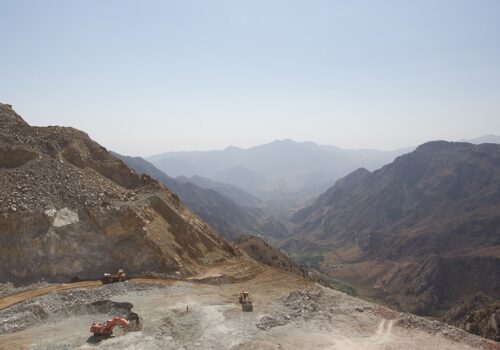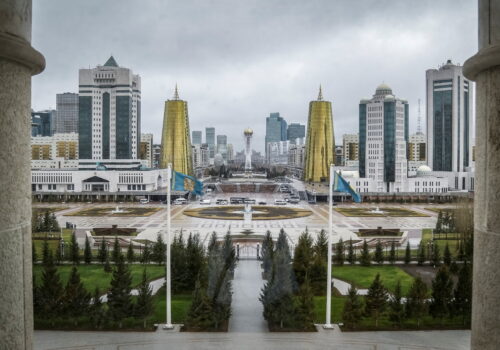Are small modular reactors in Kazakhstan’s nuclear energy future?
On March 15, Kazakh President Kassym-Jomart Tokayev announced the creation of an agency for atomic energy, which is tasked with overseeing the construction of three nuclear power plants and, ultimately, the formation of a “full-fledged nuclear cluster.” A large-scale nuclear plant in the country’s southwest will be central to this vision. But as Kazakhstan commits to nuclear energy, is there a place for small modular reactors (SMRs) in its nuclear energy infrastructure?
The answer, according to Kazakh officials, is a cautious yes. In September 2024, Gumar Sergazin, the then head of the Department of Nuclear Energy and Industry, said that SMRs could be built in the cities of Aktau and Kurchatov after 2030. In December, Almasadam Sätqaliev, the then minister of energy who has since been appointed to lead the new atomic energy agency, announced that the government was in discussions with two US companies—NuScale and GE-Hitachi—about the potential construction of SMRs, albeit in the distant future.
Both companies have been on Kazakhstan’s radar for several years. In 2021, NuScale signed a memorandum of understanding with Kazakhstan Nuclear Power Plants, the designated owner and operator of future nuclear power facilities in the country and a subsidiary of the government’s Samruk-Kazyna National Welfare Fund. The agreement aimed to explore the deployment of NuScale’s SMR VOYGR technology in Kazakhstan. The next year, Bela Ferenczi, General Electric’s president for Russia and the Commonwealth of Independent States, signaled the company’s readiness to offer SMR technology, including the GE Hitachi BWRX-300, for Kazakhstan’s nuclear development. However, in late June 2022, the Kazakh Ministry of Energy removed both vendors from the shortlist for its first nuclear power plant project, citing the lack of a proven track record in constructing and operating these technologies worldwide.
While Kazakhstan’s immediate nuclear focus remains on a large-scale power plant, SMRs could offer several advantages. According to the International Atomic Energy Agency (IAEA), SMRs—typically with a maximum power capacity of about one-third that of traditional reactors—could provide cost savings in capital investment and shorter construction times. They could also be deployed off-grid and scaled incrementally to match growing demand. Additionally, SMRs are expected to require less frequent refueling and are considered by many nuclear experts to be safer, as they can be built underground, making them less vulnerable to earthquakes and extreme weather events.
SMR technology remains in the early stages of commercial licensing and deployment.
SMRs can also be placed on or near the sites of retired coal-fired plants. This could potentially reduce costs by avoiding the need for acquiring new land and by utilizing existing infrastructure, such as grid connections, water access, and transportation networks. The cost savings of replacing coal plants with SMRs depend in part on the characteristics of the coal plant. However, recent studies of plants in Poland and China estimated upfront savings in the range of 15 percent to 35 percent. In addition, nuclear energy is well positioned to repurpose the skills of legacy fossil-based energy sector workers. In Kazakhstan, where 66 percent of electricity is generated by coal-fired power plants and the coal industry employs approximately 32,000 people, a coal-to-nuclear transition could significantly support decarbonization and just transition efforts.
Yet, for all their appeal, SMRs are not without drawbacks. Research shows that some advanced SMRs may generate more voluminous and chemically and physically reactive waste than traditional light-water reactors. Moreover, their per-kilowatt costs may prove higher due to the loss of economies of scale, and they could suffer cost overruns during construction.
Overcoming these challenges would require government support, innovation, and new business models, the International Energy Agency (IEA) reports. Should that happen quickly enough, the IEA estimates that SMRs could account for 10 percent of all nuclear capacity globally by 2040. The United States, a leading SMR innovator but overall laggard on new nuclear plant construction, is projected to contribute 20 percent of this growth. Some investors have expressed optimism about a nuclear energy “renaissance” under the Trump administration, as US Energy Secretary Chris Wright has said that nuclear energy is a priority. However, in advanced economies such as the United States, the regulatory approval process is often slow, and the first SMRs are unlikely to be deployed there until the 2030s at the earliest. Currently, only China and Russia have operational SMRs.
Kazakhstan’s cautious approach to SMRs, therefore, reflects a broader reality: SMR technology remains in the early stages of commercial licensing and deployment. Nuclear and political experts I have spoken with generally agree that Astana is unlikely to invest in SMRs without first seeing successful reference cases elsewhere.
Across the border, Uzbekistan has taken a different approach. In 2024, Russian state corporation Rosatom signed its first-ever export contract for a six-unit SMR plant in Uzbekistan’s Jizzakh region. Each reactor will have a capacity of 55 megawatts, bringing the total to 330 megawatts once completed. The project will use the RITM-200N water-cooled reactor, an evolution of the model deployed in Russia’s floating Akademik Lomonosov power station. Notably, no land-based nuclear plants currently use this reactor, although a two-unit project is planned in Yakutia, Russia. Uzbekistan’s nuclear initiative will involve international subcontractors from China and Europe for non-nuclear components. If all goes as planned, the first unit will be operational by 2029, with the entire plant coming online by 2033.
Kyrgyzstan is considering using the same technology to address its need for more energy. In 2023, Rosatom and the Kyrgyz Ministry of Energy agreed on a roadmap for a two-unit power plant. Given the country’s mountainous terrain and small grid, SMRs present an attractive alternative to large-scale nuclear power.
As both neighbors develop their SMR potential, Kazakhstan might have more reference cases to draw from. By the time Astana completes its first nuclear power plant, advancements in research and development, an increasing number of reference projects, and reduced costs might indeed make SMRs a more viable option.
Aruzhan Meirkhanova is a policy analyst and senior researcher at the National Analytical Center, a think tank based at Nazarbayev University in Kazakhstan.
Further reading
Tue, Apr 15, 2025
Central Asia’s geography inhibits a US critical minerals partnership
EnergySource By
Central Asia holds vast critical mineral resources, but limited export capacity and complex environmental, geopolitical, and legal risks make large-scale US investment unfeasible. The US should instead focus its efforts on allied nations with established mineral export industries.
Mon, Feb 10, 2025
How Trump can unlock new strategic economic opportunities in Central Asia
New Atlanticist By Andrew D’Anieri, Katherine Spencer
Starting with the repeal of the Cold War–era Jackson-Vanik Amendment, the Trump administration could transform US policy toward Central Asian countries for the better.
Fri, Feb 7, 2025
Central Asia needs regional and international cooperation to bolster water security
Report By
A new Atlantic Council report, “Water insecurity in Central Asia: The imperative for regional and international cooperation” details the developing water crises in Central Asia and outlines strategies to combat water insecurity in the region.
Image: CHANGJIANG, CHINA - FEBRUARY 06: A 550-ton outer dome is hoisted in place at the construction site of the World's first commercial small modular reactor Linglong One, marking the main structure of its reactor building completed, on February 6, 2024 in Changjiang Li Autonomous County, Hainan Province of China. The reactor is expected to generate 1 bln kWh of power annually for 526,000 households upon operation. (Photo by Luo Yunfei/China News Service/VCG )No Use China.



